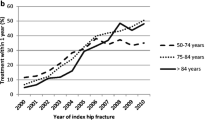Abstract
Purpose
To compare drug treatment changes in older hip fracture patients with and without multi-dose drug dispensing (MDD) after discharge from hospital.
Methods
Hip fracture patients (aged 65 years or older) for whom the same prescribing procedure was used at discharge and at the 6-month follow-up were extracted from two patient cohorts consecutively recruited in 2008 (n = 100) and 2009 (n = 99), respectively. Of these hip fracture patients, 107 patients used MDD and 47 used ordinary prescriptions (OP) throughout the study period. Drug treatment was registered at discharge and at the 6-month follow-up. Each drug was classified as changed (withdrawn, dosage adjusted or added) or unchanged. The association between MDD and changes in drug treatment was analysed with generalised estimating equations (GEE). Age, sex, cognition, year of study and type of drug (fall-risk-increasing, fracture-preventing or other) were included in the model.
Results
A total of 1,980 drugs were prescribed at discharge and at the 6-month follow-up to the 154 patients. Of the 1,413 drugs prescribed via MDD, 597 (43%) drugs were unchanged. The corresponding figure for drugs prescribed via OP was 166 out of 567 (29%) prescribed drugs. Analysis with GEE revealed an odds ratio (95% confidence interval) of 1.66 (1.20–2.31) to 1.77 (1.38–2.27) for a drug to be classified as unchanged when prescribed via the MDD system.
Conclusions
MDD is associated with fewer changes in drug treatment compared with OP. Further studies of risks and benefits from this prescribing procedure are urged.

Similar content being viewed by others
References
Leipzig RM et al (1999) Drugs and falls in older people: a systematic review and meta-analysis: II. Cardiac and analgesic drugs. J Am Geriatr Soc 47(1):40–50
Leipzig RM et al (1999) Drugs and falls in older people: a systematic review and meta-analysis: I. Psychotropic drugs. J Am Geriatr Soc 47(1):30–39
Qaseem A et al (2008) Pharmacologic treatment of low bone density or osteoporosis to prevent fractures: a clinical practice guideline from the American College of Physicians. Ann Intern Med 149(6):404–415
Sjoberg C et al (2010) Treatment with fall-risk-increasing and fracture-preventing drugs before and after a hip fracture: an observational study. Drugs Aging 27(8):653–661. doi:10.2165/11538200-000000000-00000 5
Chrischilles EA et al (2009) Inappropriate medication use as a risk factor for self-reported adverse drug effects in older adults. J Am Geriatr Soc 57(6):1000–1006
Johnell K et al (2007) The relationship between number of drugs and potential drug-drug interactions in the elderly: a study of over 600,000 elderly patients from the Swedish Prescribed Drug Register. Drug Saf 30(10):911–918
Westerbotn M et al (2006) Factors influencing the handling of medicines among very old people living at home in an urban area. Aging Clin Exp Res 18(6):497–502
Åkerlund M et al. (2011) ApoDos–The multi-dose drug dispensing of the Swedish Pharmacies (ApoDos–Apotekets dosexpedierade läkemedel). In: The Swedish Medical Products Agency (Läkemedelsverket) (ed) Book of medication 2011–2012(Läkemedelsboken 2011–2012). The Swedish Medical Products Agency (Läkemedelsverket), Stockholm, pp 1250–1254
Statens beredning för medicinsk utvärdering (Swedish Council on Technology Assessment in Health Care) (2009) Äldres läkemedelsanvändning—hur kan den förbättras? (How Can Drug Consumption among the Elderly be Improved?) Report 193. Summary and conclusions available in English at: http://sbu.se/upload/Publikationer/Content1/1/Drug_Consumption_among_Elderly_summary.pdf. Accessed 10 Oct 2011
Bakken T et al (2003) Improved medicine lists with multi-dose packaging? Tidsskr Nor Laegeforen 123(24):3595–3597
Midlov P et al (2005) Medication errors when transferring elderly patients between primary health care and hospital care. Pharm World Sci 27(2):116–120
Wekre LJ et al (2010) Multidose drug dispensing and discrepancies between medication records. Qual Saf Health Care 19(5):1–4. doi: 10.1136/qshc.2009.038745
Johnell K et al (2008) Multi-dose drug dispensing and inappropriate drug use: a nationwide register-based study of over 700,000 elderly. Scand J. Prim Health Care 26(2):86–91. doi: 10.1080/02813430802022196
Sjoberg C et al (2011) Association between multi-dose drug dispensing and Quality of Drug Treatment - A Register-Based Study. PLoS One 6(10):e26574. doi:10.1371/journal.pone.0026574 PONE-D-11-10309
Kragh A (2004) Two out of three persons living in nursing homes for the elderly are treated with at least ten different drugs. A survey of drug prescriptions in the northeastern part of Skane. Lakartidningen 101(11):994–996, 999
van der Velde N et al (2007) Risk of falls after withdrawal of fall-risk-increasing drugs: a prospective cohort study. Br J Clin Pharmacol 63:232–237. doi:10.1111/j.1365-2125.2006.02736.x
Hidle U (2007) Implementing technology to improve medication safety in healthcare facilities: a literature review. J N Y State Nurses Assoc 38(2):4–9
Modig S et al (2009) Frail elderly patients in primary care—their medication knowledge and beliefs about prescribed medicines. Eur J Clin Pharmacol 65(2):151–155. doi:10.1007/s00228-008-0581-8:
Acknowledgements
The study was supported by the National Board of Health and Welfare. The funding source did not influence design, methods, subject recruitment, data collections, analysis, preparation of paper or the decision to submit the paper for publication.
Conflict of interest
The authors declare that they have no conflict of interest.
Author information
Authors and Affiliations
Corresponding author
Rights and permissions
About this article
Cite this article
Sjöberg, C., Ohlsson, H. & Wallerstedt, S.M. Association between multi-dose drug dispensing and drug treatment changes. Eur J Clin Pharmacol 68, 1095–1101 (2012). https://doi.org/10.1007/s00228-012-1230-9
Received:
Accepted:
Published:
Issue Date:
DOI: https://doi.org/10.1007/s00228-012-1230-9




